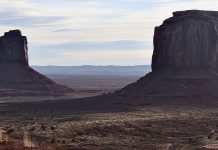SHIPROCK, N.M., Aug. 13 (UPI) — The Navajo Nation vowed to sue the U.S. Environmental Protection Agency over a toxic wastewater spill into waterways throughout the Southwest and warned tribal residents to avoid signing the EPA’s compensation form because it will effectively sever their legal and financial rights.
Navajo Nation President Russell Begaye ordered the nation’s Department of Justice to take action against the EPA and signed a directive banning the agency from distributing information about the federal compensation regarding the spill from the Gold King mine, north of Silverton, Colo., into the Animas and San Juan rivers and its tributaries throughout Colorado, New Mexico and Utah.
Navajo Nation Attorney General Ethel Branch said the federal form “contains offending language that will waive future claims for individuals that sign the form and preclude our people from seeking full compensation for injuries” suffered as a result of the release of some three million gallons of toxic mine waste on Aug. 5.
“The spill has impacted us religiously, emotionally, financially,” Begaye said, adding it has affected more than 100,000 Navajo residents, cutting off drinking water and water for irrigation and farming.
“Relocated farmers now need to buy hay and haul water; others living along the river are forced to drive up to 200 miles to find bottled water. People with an average salary of $12,000 are expending dollars on things that they wouldn’t have,” Begaye said.
Wednesday, EPA Administrator Gina McCarthy ordered a halt to the agency’s clean-up work at the Gold King mine and other sites, pledging a thorough investigation into the accident cause in part by the agency’s own contractors, Environmental Restoration LLC, a St. Louis-based firm.
“It is a heartbreaking situation,” McCarthy said in a news conference in Durango, Colo.,about 48 miles downstream from the spill site. “We are going to be transparent and collaborative in making sure people have the information they need.”
The EPA has come under harsh criticism from the Navajo Nation, state governments and other environmental organizations for its response to the spill, which happened as an earthen barrier gave way at the gold mine, sending orange-colored sludge containing high levels of arsenic and lead into the waterways. Initially, officials said the spill was some one million gallons but later tripled the number.
During her tour of the area, McCarthy said the river “seems to be restoring itself,” but Navajo Nation officials scoff at the idea. They said the area needs to be declared a Superfund cleanup site, which provides larger amounts of federal funding.
“They are not going to get away with this,” Begaye said. “The EPA was right in the middle of the disaster, and we intend to make sure the Navajo Nation recovers every dollar it spends cleaning up this mess and every dollar it loses as a result of injuries to our precious Navajo natural resources.”







